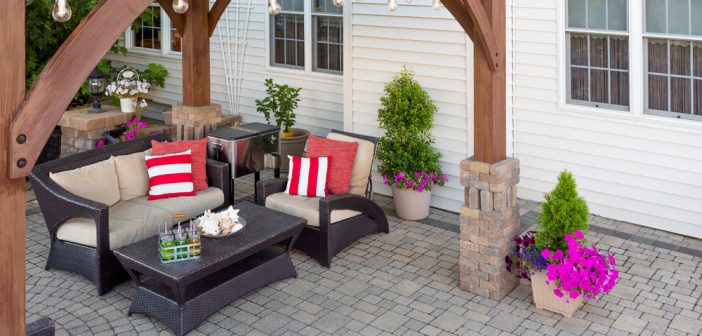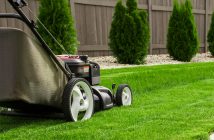If you have ever experienced the frustration of removing your outdoor furniture from storage and finding it rusting or covered in mold and mildew, you know how disappointing this can be. Fortunately, you can make sure that this does not happen next season by following a few simple steps to protect your furniture through the winter months.
1. Give it a Good Cleaning
This first step is, perhaps, one of the most important steps in getting your outdoor furniture ready for winter storage. Storing furniture with dirt, debris, or food stuck in the crevices can lead to the development of mildew and mold. You should also be sure to thoroughly dry your furniture once it is clean.
Of course, not all outdoor furniture is made from the same material, so there are things to consider when it comes to cleaning different materials. For instance, furniture made from plastic can be cleaned with detergent. However, furniture made from teak or cedar may require you to apply a solution containing bleach to kill the mildew. The solution will need to remain on the furniture for one or two days. You will then need to sand the surface with 120-grit sand paper. Next, you should apply tung oil. Properly treated teak and cedar furniture can be left outdoors if you prefer.
For furniture comprised of wood, you should use a solution of bleach, water, and detergent. For applying the solution, you should use a sponge that is slightly abrasive. Once all of the debris is removed, you can simply rinse with water and let it dry. If you have wicker furniture, you can simply use a solution of water and bleach. However, you must be sure to rinse with a gentle spray of water and let it dry thoroughly.
To clean your metal furniture, you will need a brush, some water, and some detergent. Using the brush, you must scrub off all of the dirt. Once it is clean, you can then easily rinse it with water and let it dry.
2. Cushions
Because cushions are notorious for having tiny little crevices where food, dirt, and debris can hide, it is extremely important to clean them before you put them into winter storage. If you do not, you may encounter a huge mess of mold and mildew the following season.
For cushions with removable covers, you can simply follow the manufacturer’s cleaning instruction. Usually you will need to place them in your washer on gentle cycle. If allowed, you can add bleach to kill any mildew.
If your cushion cannot be machine washed, you can use a mild detergent along with a brush and cloth as needed. It is recommended to allow covers to air dry–even if machine drying is allowed. Once the covers are dry, you can place them back on the cushions.
3. Give it a Good Coating
For metal furniture, it is important to thoroughly inspect all the surfaces for rust or oxidation. Any rust you find should be treated with a rust-neutralizing primer. You can also use steel wool to help remove the rust. Next, you should apply a paint that closely matches the original color. For extra added protection, you can apply a silicone sealant.
If your wood furniture needs to some touching up, now is the time to do it. Once any touch ups are completed, you can apply a clear, water-based repellent. You can also apply paste for an additional layer of protection.
As a final touch, you can easily use spray paint to touch up your wicker furniture. Finally, it is also important to apply a moisture repellent on the legs and feet.
4. Covers
Sometimes it is not possible to store your outdoor furniture in a garage or shed. However, it is still possible to protect your furniture. Fortunately, covers come in all shapes and sizes and are designed to withstand inclement weather. A helpful hint when using a cover outdoors is to affix it in such a way that prevents sudden gusts of wind from removing it. Additionally, for some extra protection, you can even use covers on the furniture you store in your garage or shed.
5. Umbrellas
If you have an umbrella, you should make sure to clean it using a mild detergent and a brush. Once it is clean, you should leave the umbrella open until it is completely dry. It is also very important to lubricate any switches, pivots, or locks before you close the umbrella for storage. To protect against any mold or mildew, you should make sure to wrap the umbrella in a plastic drop cloth. Once wrapped, you can use tape to seal it closed.
6. Hammocks
As with all other outdoor furniture, cleaning your hammock made of cloth or rope before storing it for the winter is extremely important. It is also quite easy. You can simply place the hammock in your washing machine and add detergent. To dry, you can lay it flat and let it air dry. Once it’s dry, you can fold it up, and it is ready to store indoors.
7. Storage
The final step in storing your outdoor furniture involves where and how to place it indoors. Whether you use a shed or your garage, you should make sure that no water will reach the furniture. However, there are a few things to consider regarding the various types of materials outdoor furniture is comprised of.
For instance, for plastic furniture, you should make sure to store it in a place that the temperature will not drop below freezing as low temperatures can crack the furniture. Wicker should be stored in a dry place as well as off the ground for added assurance that the feet remain dry.
When storing your cushions, try to stack them loosely in a dry space. Do not store them on the floor. Additionally, placing them in a waterproof bag or plastic box can help them to last longer.
Please note: if you reside in an area that experiences high humidity, you should wrap the cushions in sheets or blankets before placing them in a bag or box as bags and boxes block air circulation and might promote mildew.
Finally, in the interest of saving space, you can stack your chairs and tables on top of each other. As previously mentioned, you can use a cover for an extra layer of protection.









